Seawater sampling @ Shinagawa
先日、品川駅近くまで海水のサンプリングに行ってきました~。すごく良い天気で、長袖だと暑いぐらいでしたね。
We went to Shinagawa for sampling of seawater. It was a very fine day!
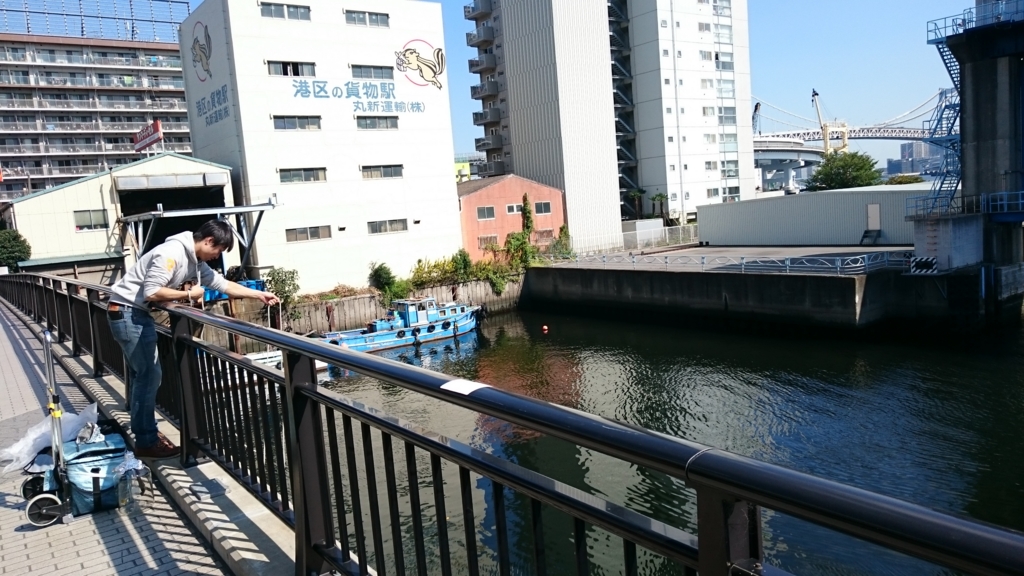

▲Pictures of seawater sampling
K. HIKI
Lab Meeting in 2015 Winter
こんにちは、日置です。
今学期も本研究室では、所属教員・学生が集まってのミーティングをほぼ毎週行います。(前学期のミーティングに関してはこちら参照。)
Also in this semester, Lab Meeting will be held to share the knowledge of each student/researcher. All students and researchers in our laboratory are expected to attend this meeting.
スケジュール Schedule
毎回、論文紹介(または各自の研究の進捗報告)を順番におこないます。今学期はスペシャルゲストにも来ていただく予定です*1!
I would like all presenters to introduce a scientific paper or their own research progress. The schedule is shown in the following table. We have a special guest in this semester ...

紹介された論文たち Papers introduced in the meeting
以下は、Lab meetingで紹介された論文です。随時更新します。
- Clark S.L. et al., 2015, Comparative sensitivity of field and laboratory populations of Hyalella azteca to the pyrethroid insecticides bifenthrin and cypermethrin, Environ. Toxicol. Chem., 34(10), 2250-2262.
- Palma P. et al., 2016, Ecotoxicological endpoints, are they useful tools to support ecological status assessment in strongly modified water bodies?, Sci. Total Environ., 541, 119-129.
- Cooper C.A. et al., 2013, Influence of salinity and dissolved organic carbon on acute Cu toxicity to the rotifer Brachionus plicatilis, Environ. Sci. Technol., 48, 1213-1221.
- Li H. et al., 2015, Effects of Tris (1,3-dichloro-2-propyl) Phosphate on growth, reproduction, and gene transcription of Daphnia magna at environmentally relevant concentrations, Environ. Sci. Technol., 49(21), 12975-12983.
- Campana O. et al., 2012, Sub-lethal effects of copper to benthic invertebrates explained by sediment properties and dietary exposure, Environ. Sci. Technol., 46, 6835-6842.
- Bhattacharjee A.S. et al., 2015, Bacteriophage therapy for membrane biofouling in membrane bioreactors and antibiotic‐resistant bacterial biofilms, Biotechnol. Bioeng., 112(8),1644-1654.
- Pavlaki M.D. et al., 2014, Changes of chemical chronic toxicity to Daphnia magna under different food regimes, Ecotoxicol. Environ. Safety, 109, 48-55.
- de Boer T.E. et al., 2015, Combined transcriptomics analysis for classification of adverse effects as a potential end point in effect based screening, Environ. Sci.Technol., 49(24), 14274-14281.
今学期に紹介された8本中4本がESTだったようです。
さらに追記。2016年度の夏学期に紹介された論文たちです。
- Taylor N.S. et al., 2016, Predicting chronic copper and nickel reproductive toxicity to Daphnia pulex-pulicaria from whole-animal metabolic profiles, Environ. Pollut., 212, 325-329.
- Piggott M.P., 2016, Evaluating the effects of laboratory protocols on eDNA detection probability for an endangered freshwater fish, Ecol. Evolution, 6(9), 2739-2750.
- Lee S., 2016, Crossing the Border between Laboratory and Field: Bacterial Quorum Quenching for Anti-Biofouling Strategy in an MBR, Environ. Sci. Technol., 50(4), 1788-1795.
- de Haas E.M. et al., 2004, Combined effects of copper and food on the midge Chironomus riparius in whole-sediment bioassays, Environ. Pollut., 127(1), 99-107.
- Halpern B.S. et al., 2012, An index to assess the health and benefits of the global ocean, Nature, 488(7413), 615-620.
- Wold S. et al., 2001, PLS-regression: a basic tool of chemometrics, Chemometrics Intell. Lab. Systems, 58(2), 109-130.
- Burgess R., 2001, An improved protocol for separating meiofauna from sediments using colloidal silica sols, Mar. Ecol. Prog. Ser., 214, 161-165.
- Yates E.A. et al., 2002, N-acylhomoserine lactones undergo lactonolysis in a pH-, temperature-, and acyl chain length-dependent manner during growth of Yersinia pseudotuberculosis and Pseudomonas aeruginosa, Infection and Immunity, 70(10), 5635-5646.
- Barnes M.A. et al.,2014, Environmental conditions influence eDNA persistence in aquatic systems, Environ. Sci Technol., 48(3), 1819-1827.
- Nye J.A. et al., 2013, The relative impact of warming and removing top predators on the Northeast US large marine biotic community, Ecol. Modelling, 264, 157-168.
K. HIKI
*1:引き受けて下さって本当にありがとうございます!今から楽しみです。
WET 2015 conference
8/5-6に日本大学で開催されたWET2015(Water and Environment Technology Conference 2015)に参加してきました。
We attended WET2015 held at Nihon University on 5th and 6th August.
本研究室のNiyommaneeratさんと柳原さん、日置、そして古米研のPhungsaiさんが「The WET Excellent Presentation Award」を受賞しました!
Wilailuk Niyommaneerat, Miina Yanagihara, Phanwatt Phungsai and I got "The WET Excellent Presentation Award".
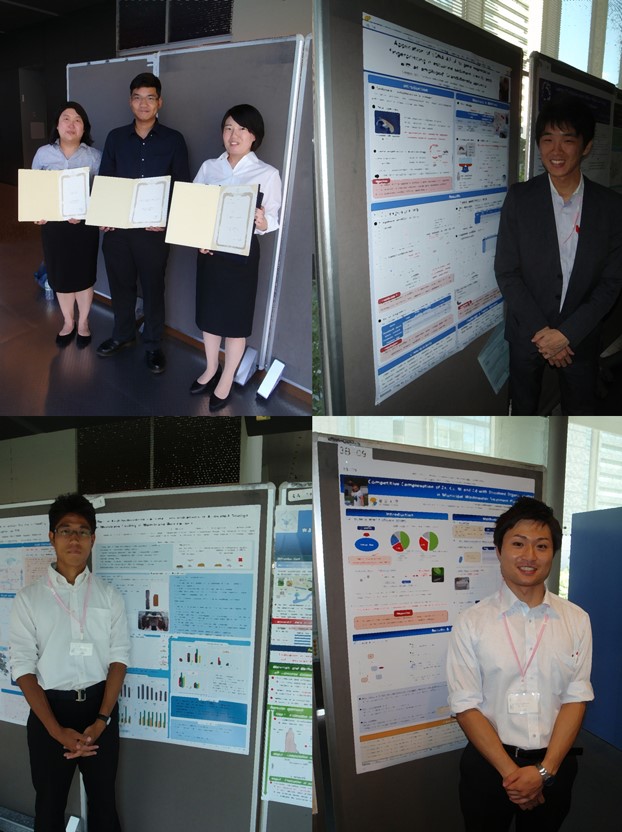
▲Our lab members in WET2015
K.HIKI
2015年夏学期の輪講:統計モデリング入門
こんちは、日置です。
今学期の輪講は「データ解析のための統計モデリング入門」(久保拓弥)を教科書にして、一般化線形モデルなどについて勉強しました。
We had RINKO, a class organized by students, about "statistical modelling" in this semester using the following textbook.

データ解析のための統計モデリング入門――一般化線形モデル・階層ベイズモデル・MCMC (確率と情報の科学)
- 作者: 久保拓弥
- 出版社/メーカー: 岩波書店
- 発売日: 2012/05/19
- メディア: 単行本
- 購入: 16人 クリック: 163回
- この商品を含むブログ (23件) を見る
●内容 Contents
有名な教科書なので、検索すれば内容はだいたい分かると思います。ざっくり書くと、「データ・現象をどのようなモデル(=数式)で説明できるか/すべきか」をテーマにした本です。具体的には最尤法、一般化線形モデル(GLM; Generalized Linear Model)、階層ベイズモデルなどが登場します。実際の計算は無料の統計ソフトRを用いておこないました。
●輪講のスケジュール Schedule
全部で13回の講義をおこないました。
初回は輪講内容・進め方のガイダンスとRの使い方説明に充てました。2回目から11回目までは、教科書の2章~11章を各自1章ずつ読んできて紹介しました。12回目は文献紹介などの補足発表で、13回目は打ち上げでした。
参考までに初回講義のRの使い方と、12回目の文献紹介(p値について)で使用したスライドをアップロードしておきます。どちらも輪講のメイン内容ではないですが…。輪講の雰囲気が伝われば幸いです。
●感想 impression
評判通りの面白く分かりやすい教科書。*1データをモデルにあてはめた経験は、自分はぶっちゃけ最小二乗法による線形回帰ぐらいでした。そんな自分でも、非常に分かりやすくGLM・GLMM・階層ベイズなどを学べました。
ただ詳細は深入りせずに概念の理解をしやすいように書かれてるので、ぼーっと聞いてても「なんとなく分かった気になる」だけかもしれません*2。いざ自分でやろうという時には、もう一度勉強し直さないといけないような…。まあモデリングに関する一通りの概念地図みたいなものが頭に描けただけでも、大きな収穫でしょう。
●これまでの輪講
ちなみにこれまでの輪講では、数理生態学(2014年冬)や放射性物質(2014年夏)をテーマにしてました。2007年以前の輪講で扱ったテーマは、ここに記録が残っています。
The themes of the previous RINKO were, for example, "mathematical ecology" and "radioactive materials".
K. HIKI
Our paper was accepted (WST, 2015)
このブログでもお馴染みのニホンドロソコエビを用いて道路塵埃(路面上に堆積しているチリやホコリ)の毒性を調べた論文が、Water Science and Technology誌に受理されました!!わーい。
Kyoshiro Hiki and Fumiyuki Nakajima: Effect of salinity on the toxicity of road dust in an estuarine amphipod Grandidierella japonica, Water Science and Technology, accepted. (→Link)

●論文の概要
この論文は、道路塵埃の有害性をバイオアッセイ(生物応答を指標とする試験)によって調べた研究です。「底生生物に対する道路塵埃の致死毒性が塩分によって増加した」ことを明らかにした初めての論文です(下図)。
正直な話突っ込みどころもかなりありますが…、塩分と道路塵埃の毒性を結び付けた視点は新しいんじゃないかと自負しています。
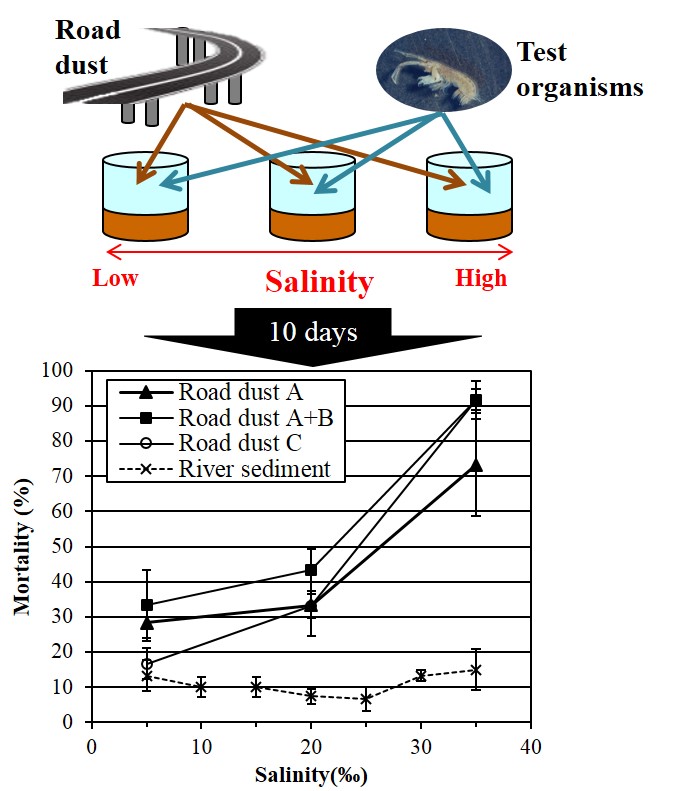

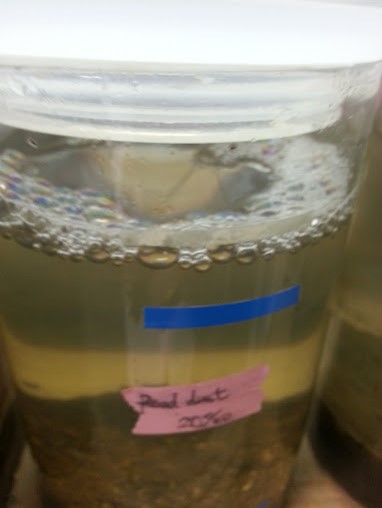
●Short abstract
Increasing salinity from 5‰ to 35‰ resulted in high mortality of the estuarine amphipod for the three road dust tested. This finding suggests that the salinity level in receiving waters is an important factor on road runoff toxicity.
川から泥を採ってきたよ!
こんにちは、日置です。
昨日6/15は、底質汚染の調査のために都内の河川へサンプリングに行ってきました。
Yesterday we went to rivers in order to take sediment samples.
●サンプリングのようす
橋の上から小さな採泥器(van veen grab)を用いて泥を採取しました。
Sediment sampling was conducted as shown in the picture below.

▲橋の上から底質を採取しています
当初予定した橋では川底に泥がたまっておらず、 泥を探して橋をいくつか巡らないといけませんでした。良い天気だったので、ちょっとしたピクニック気分でした。アイスもご馳走して頂きました~。ありがとうございます。
We traveled around from bridges to bridges. It's like a picnic.
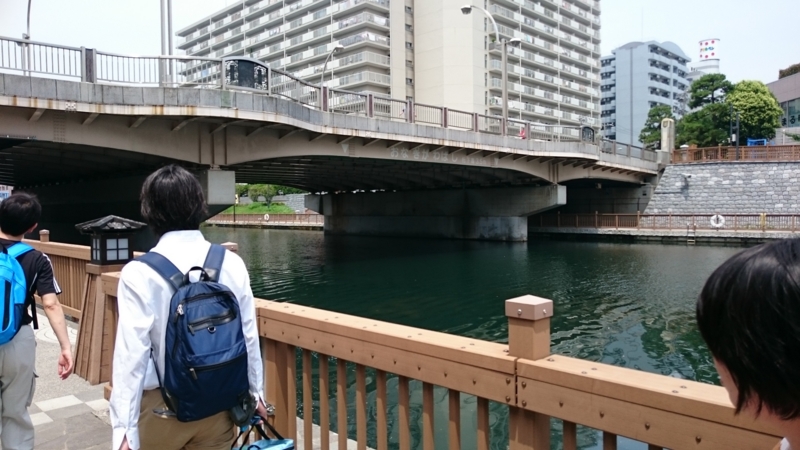

▲採取した底泥

K.HIKI
